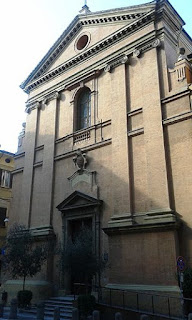Artist from Baroque period who excelled in genre painting
 |
| One of the most well-known of Crespi's genre paintings, The Flea |
Crespi also painted portraits and caricatures as well as religious paintings, especially at the beginning and end of his career. Even in his religious work, the scenes would include ordinary people, such as his acclaimed series, the The Seven Sacraments, originally commissioned by Cardinal Pietro Ottoboni in Rome, which now hangs in the Gemäldegalerie Alte Meister - the Old Masters’ Gallery - in Dresden.
Growing up in Bologna, he learned the basics of drawing and painting from Angelo Michele Toni, to whom he was apprenticed at the age of 12. His taste in clothes - he favoured the tight garments characteristic of Spanish fashion - earned him the nickname Lo Spagnuolo - the Spaniard. After leaving Toni, he spent much time studying and copying the work around the city of the Carracci brothers - Annibale, Agostino and Ludovico - whose fresco decorations adorned the cloister of San Michele in Bosco and the Palazzo Magnani and Palazzo Fava. Their work proved to be a lasting influence.
After working for a short time in the studio of Domenico Maria Canuti, he returned to independent study before entering the studio of Carlo Cignani, the leading exponent of Bolognese classicism. When Cignani moved to nearby Forlì, Crespi and his friend Giovanni Antonio Burrini rented Cignani’s studio, Crespi soon adopting Burrini's use of colour in the Venetian style.
 |
| Confirmation - the second in Crespi's cycle, The Seven Sacraments |
It is thought that it was in the 1690s that Crespi established himself, moving away from accepting commissions for altarpieces and other traditional religious work towards painting scenes from everyday life, featuring labourers and other people in the lowly occupations, acquiring a clientele of wealthy private collectors and connoisseurs. Thanks to the demand for his work, he was comfortable financially for the remainder of his career.
Crespi’s focus on genre painting marked a change in Italy, where until the 17th century painters had largely concentrated on grander images from religion, mythology, and history. There were some exceptions. Annibale Carracci occasionally painted tradespeople and both Bartolomeo Passerotti and Vincenzo Campi produced some work in the style, but it was more of a tradition in northern Europe, especially the Netherlands.
Of all Crespi’s genre paintings, which featured peasants or domestic servants but also singers and musicians and men playing gambling games, one of the best known is The Flea, painted around 1709 or 1710, which shows a woman sitting on a bed, searching her clothes for a flea. He painted a number of versions, all featuring a drab, modestly furnished room with a dog, evidently her companion, lying on the bed.
Crespi is said to have become somewhat reclusive late in after the death of his wife, returning to religious themes and seldom being seen in public apart from at mass.
He died in Bologna in 1747 at the age of 82. Two of his sons, Antonio and Luigi themselves became painters. Giovanni Battista Piazzetta, Pietro Longhi, Giacomo Ceruti and Giandomenico Tiepolo - son of Giovanni Battista Tiepolo - are four painters who were probably influenced by his work.
 |
| The Pinacoteca Nazionale di Bologna was founded at the city's Academy of Fine Arts |
The Pinacoteca Nazionale di Bologna, which houses a number of Crespi’s paintings, dates back to 1808, when it was founded as a gallery annex of the city’s Academy of Fine Arts. The core of the collection was enhanced by the addition of many hundreds of paintings rescued from convents, churches, religious educational institutes and other places ahead of the entrance of Napoleon’s French troops between 1797 and 1810. The premises were extended between 1914 and 1920 when a new wing was constructed, and in the 1960s and 70s with the addition of the large Renaissance hall and the restructuring of the entrance hall. For more information, visit https://www.pinacotecabologna.beniculturali.it/en/home
 |
| Piazza Maggiore, overlooked by the Basilica of San Petronio, is at the centre of Bologna |
Bologna is one of Italy's oldest cities. It can be traced back to 1,000BC or possibly earlier, with a settlement that was developed into an urban area by the Etruscans, the Celts and the Romans. The University of Bologna, the oldest in the world, was founded in 1088. Bologna's city centre, which has undergone substantial restoration since the 1970s, is one of the largest and best preserved historical centres in Italy, characterised by 38km (24 miles) of walkways protected by porticoes. At the heart of the city is the beautiful Piazza Maggiore, dominated by the Gothic Basilica of San Petronio, which at 132m long, 66m wide and with a facade that touches 51m at its tallest, is the 10th largest church in the world and the largest built in brick.
Also on this day:
1820: The birth of Victor Emmanuel II, the first King of a united Italy
1825: The birth of astronomer Giovanni Schiaparelli
1972: The strange death of publisher Giangiacomo Feltrinelli

























